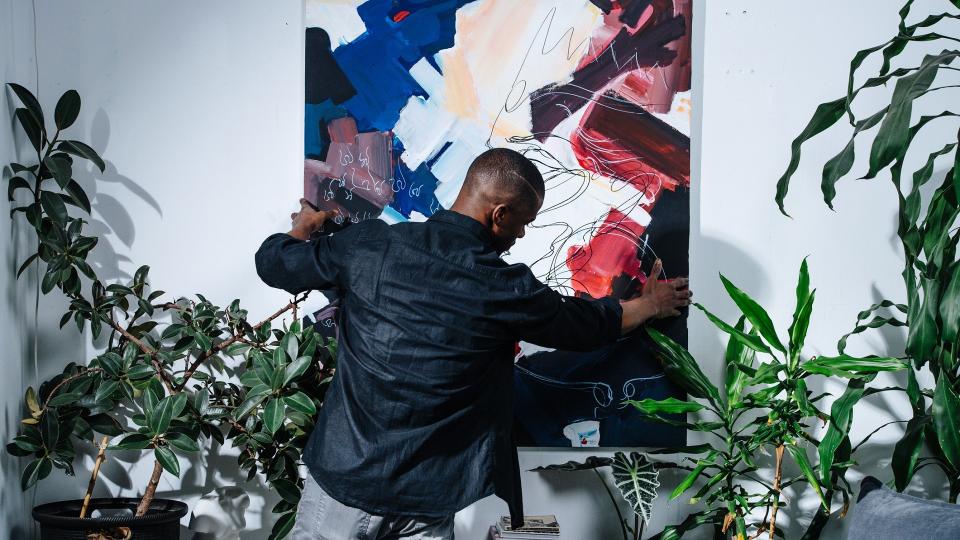
Grant Cardone, private equity fund manager, real estate investor, author of “The 10X Rule” and creator of the 10X Profit Planner, has a multi-million-dollar art collection, which he showcased in a recent YouTube video.
Check Out: In 5 Years, These 2 Stocks Will Be More Valuable Than Apple
Read Next: 4 Genius Things All Wealthy People Do With Their Money
From an Alexander Calder piece, sold for $44,475 and which he tried “not to buy,” to a Romero Britto piece which he said he bought at a charity event — the collection is quite extensive and varied.
Yet, while investing in art can make sense for the super wealthy, should you invest in this asset too?
Wealthy people know the best money secrets. Learn how to copy them.
What Is Art Investing?
Art is a form of alternative investment, yet, according to an Alto survey, only 20% of Americans are knowledgeable about alternative investing and only 2.2% said they own art as an investment.
“Investing in art has a long, colorful history of patronage and trendsetting that stretches back hundreds of years. But that was the old way to do it. Now, there is Masterworks, YieldStreet, Artelier, and others who will happily take your investment in exchange for a piece of the action on already popular artwork,” said Stephen Kates, CFP, principal financial analyst, Annuity.org.
As Kates noted, however, investing in art the old-fashioned way is a harder market to predict and depends largely on your access to work by artists who are or could be popular.
“Someone like Cardone has access to professional help that the average person cannot afford,” he said. “He also has a level of disposable income that allows him to buy and hold art indefinitely without much concern for the future price or value. This isn’t always the case for the average investor.”
Pros
Eric Satz, founder and CEO of Alto, previously told GOBankingRates that while collectible art has also historically been out of reach for most investors, this is rapidly evolving, thanks partly to technology and the fractionalized ownership scenarios it enables at scale.
“Overall, I think interest in investing in art stems from investors wanting to invest in what they love. You may not get to look at it on your wall, but you can reap the benefits from an investment standpoint,” he added at the time.
Indeed, one pro of investing in art is low correlation with other asset classes.
“Studies have found this to be the case. A 2022 CitiBank report indicated that the correlations between blue chip art and any other asset class are weakly positive or close to zero,” said Robert R. Johnson, PhD, CFA, CAIA, professor of finance, Heider College of Business, Creighton University.
One investor who decided to invest via fractionalized ownership with Masterworks — which offers fractional ownership of art — is Jim Wang, founder of WalletHacks.com.
Wang said he has $60,000 in two Banksy pieces, two Basquiat pieces, a Keith Haring piece and a Gerhard Richter piece. “Based on their secondary market sales on Masterworks, it’s an ‘on paper’ return of 6.6% total over these three years, so not great!”
For him, the pros of investing in art include that as there is no open market, you don’t get updates on price — in turn, your emotions don’t influence your actions.
“If I saw the price per share dropping, I might be pushed to sell it to cut my losses (or the reverse),” said Wang.
Yet, he also added that he thinks this applies more to if you owned valuable and famous pieces outright, as you could get a loan against the value as a way to access cash flow.
“It is similar to borrowing against a stock portfolio, except you can still enjoy your art hanging on the wall,” he said.
Cons
For Wang, some of the disadvantages of investing in art is that it is very illiquid.
“I bought the shares in six pieces of art a few years ago, in 2021, and none of them have been sold,” he said. “As a tiny shareholder, I can’t even push to get them sold. You can sell your shares on a secondary market, run by Masterworks, but for the whole piece you just have to wait.”
Another con, according to him, is that “it’s a little opaque.”
“Art is sold at auctions and in private transactions, not on an exchange where price discovery is out in the open,” he added.
According to Johnson, another factor is the large divergences in value, and while some may report that art has outperformed other asset classes, much of the outperformance is driven by a relatively few pieces of art that value has soared.
“Some would say the same can be said for the stock market,” said Johson. “While that is true, literally anyone can buy shares in any stock. That is not the case for art.”
And of course, with fractionalized ownership, a big drawback is that “you don’t even enjoy the art hanging on the wall,” he said.
“It’s in a gallery somewhere,” added Wang. “If you wanted to own art outright, I imagine you’d want to stick with famous artists with name recognition and the entry point is likely going to be very high. It’s probably not feasible to the everyday investor.”
Asked why he decided to invest in art in the first place, Wang said that when it became more accessible, he thought “why not?”
“Everyone knows Banksy (the first one I invested in) and so I thought why not put some money in. Owning it and hanging it on your wall might be romantic, owning a share and having it in a gallery isn’t as exciting!,” he added. “Personally, I think it’s a fun little diversion, it’s way better to invest it in a low cost index fund. That money would’ve been way better off in the market over these last three years, that’s for sure!”
More From GOBankingRates
This article originally appeared on GOBankingRates.com: Grant Cardone Has a Multimillion-Dollar Art Collection — Should You Invest in Art Too?

